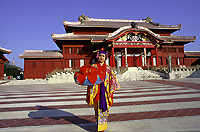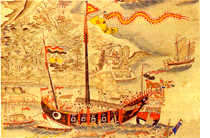Kyushu-Okinawa Summit 2000
Outline of Kyushu-Okinawa Summit Meeting


![]()
 Shuri Castle |
Post 12th century Okinawa Island contained three rival kingdoms based on southern, central and northern Okinawa Island. They called themselves Hokuzan principality (northern region), Chuzan principality (central region) and Nanzan principality (southern region) and were at war for control of the island. This period of struggles is known as the Sanzan (Three Principalities) period. King Sho Hashi, originally of the Nanzan principality, unified the three kingdoms at the beginning of the 15th century, and the Ryukyu Kingdom was born. A coup d'état in 1469 upon Sho Hashi's death brought an end to the first political unification of Okinawa under the First Sho Dynasty. The Second Sho Dynasty was established the following year, and continued until 1879. At the beginning of the 16th century, the Ryukyu Kingdom extended to the Amami Islands, the Miyako Islands and the Yaeyama Islands. Ryukyuan trade during the Sho Dynasties revolved around tributary trade with China begun during the Sanzan Period. Ryukyuans also acted as agents for vigorous transit trade with Japan and the Korean Peninsula to the north, and Siam, Malacca and Luzon to the south, among others. Foreign trade was the foundation of the Ryukyu Kingdom economy. This period was the zenith of the development of Ryukyuan culture during which the "Omorosaushi," a compilation of ancient festival songs, was written, and Enkakuji Temple and Shurei Gate were built. |
![]()
 Scroll Depicting the Ryukyu Dynasty Era (Photo by Okinawa Prefectural Museum) |
In 1609, the Ryukyu Kingdom was incorporated into the Edo Shogunal system of Japanese government as a result of the invasion by the Satsuma (clan), though it continued to retain its own royal system and relationship with China. The resulting influx of Japanese culture brought about a second golden age of Okinawan culture. The crafts, performing arts and literature achieved great success during this period. Superior works were especially abundant during the 18th century, and it is known as the period of Okinawan cultural renaissance. |
 |
 |
Back to Index
